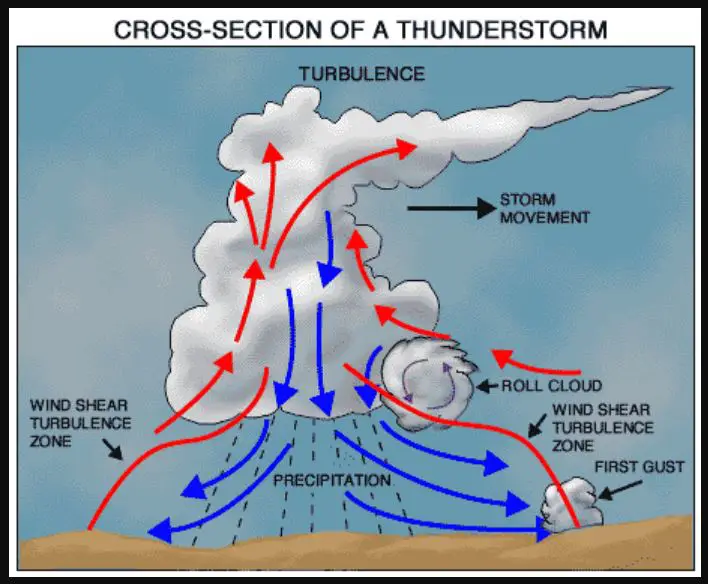Table of Contents
Thunderstorms and Tornadoes | UPSC – IAS
Thunder and tornadoes are the violent storms represent external events and atmospheric hazards. They discharge large amount of energy in an extremely short time. Tornadoes are the most violent of all such storms and wreak great havoc. They are too small in horizontal extent and hardly appear in weather charts. Because of the destruction and death they leave, they have always been an important subject for investigation.
- The most amazing feature of these storms is the fact that they are too small and short lives as to make their prediction very difficult. They strike with lightning speed so that within few minutes they destroy buildings and damage standing crops, make human life miserable.
- Thunderstorms have been defined as “storms produced by cumulonimbus clouds and always accompanied by lightning and thunder, followed by heavy rain and sometimes hail.”
Origin and structure of Thunderstorms | UPSC – IAS
- Thunderstorms originate from cumulonimbus clouds. According to Trewartha thunderstorms is like a thermodynamic machine in which the potential energy of the latent heat of indentation is rapidly converted in to the kinetic energy of ascending air currents. Thunderstorms represent the weather phenomenon which combines strong wind, thunder, lightning and torrential rains.
- The vertical extent of a thunderstorm depends on the intensity of ascending air currents. The height of thunderstorms ranges from 4 to 20 kms. Besides there is a marked seasonal and latitudinal variation in the heights usually thunderstorms develop in summer in tropical and the middle latitude regions due to the adequate supplies of moisture.
- Thunderstorms form when moist, unstable air is lifted vertically into the atmosphere, lifting of this air results in condensation and the release of latent heat. Immediately after lifting begins, the rising warm moist air begins to cool because of the adiabatic expansion. At certain height the dew point is reached resulting in condensation and formation of a cumulus cloud. The cumulus clouds grow into cumulonimbus cloud. When these clouds reaches a height of 20 kms, they create thunder, lightning, intense rain and tornadoes.
Two types of thunderstorms are common
- Air mass thunderstorms of the mid latitudes in summer and at the equator all year along
- Thunderstorms associated with mid latitude cyclones
life Cycle of Thunderstorms | UPSC – IAS
Air mass thunderstorms normally develop in the late afternoon. The life cycle of these thunderstorms have three stages: 1) Cumulus stage, 2) Mature stage 3) Dissipating stage.
- Cumulus stage: In this stage, the parcel of humid warm air rises and cools to form cumulus clouds. When the updraft reaches maximum altitude of 12 to 14 kms, they change their direction 1800 and become downdrafts
- Mature stage: With the downdrafts, precipitation begins to form and becomes cumulonimbus cloud. In this stage the thunderstorms is several kms in diameter. The mature air mass thunderstorm creates heavy rain, thunder and lightning.
- Dissipating stage: In this stage the thunderstorms begins to decrease in intensity and the convective storms move downward. Within 1 hour the storm is finished and precipitation has stopped.
Distribution:
In the N & S hemisphere from latitude 600 pole ward the frequency of thunderstorms is least. They are most frequent in humid regions of the tropics. According in Blair, in Panama, Java and equatorial Africa, the average number of thunderstorms is about 200 per year. The rocky mountain regions of US will have a maximum of 73 thunderstorms per year.
About Tornadoes | UPSC – IAS
A tornado is a dark funnel-shaped cloud made up of violently rotating winds that can reach the speeds of up to 450 kms per hour. The diameter of a tornado can vary between few meters and a kilometer, and its track can extend from less than a kilometer to several hundred kilometers. Tornadoes generally travel in a northeast direction (depending on the prevailing winds) at speeds ranging from 40-100 kms per hour.
- A Tornado is a vortex of rapidly moving air associated with severe thunderstorms. Winds within the tornado tunnel may exceed 900 kms per hr. High velocity of winds cause most of the damage associated with these weather events. The air pressure at the tornado center is approximately 800 mbs. The destructive path of the tornado is usually about half a km wide and no more than 25 kms long. The velocity of the tornado is measured by Fujita ado Intensity Scale also called as F-scale. According to the F scale strong tornado can have a wind speed between 182 and 332 kms per hour. The F4 & F5 [333 to 513 km] tornados are very destructive and violent, but they are very rare.
- Tornadoes occur in many parts of the world, notably South Africa, Australia, Europe, New Zealand, Northern India, Canada, Argentina and the United States. In US about 40,000 tornadoes have occurred in the last 50 years. Oklahoma receives more tornadoes than any other part of the world.
- On the other hand tornadoes are dark, funnel-shaped clouds containing violently rotating air that develops below a heavy cumulonimbus cloud mass and extends toward the earth. In comparison with a cyclone, a tornado covers a much smaller area but is much more violent and destructive. The atmospheric conditions required for the formation of a tornado include great thermal instability, high humidity, and the convergence of warm, moist air at low levels with cooler, drier air above.


